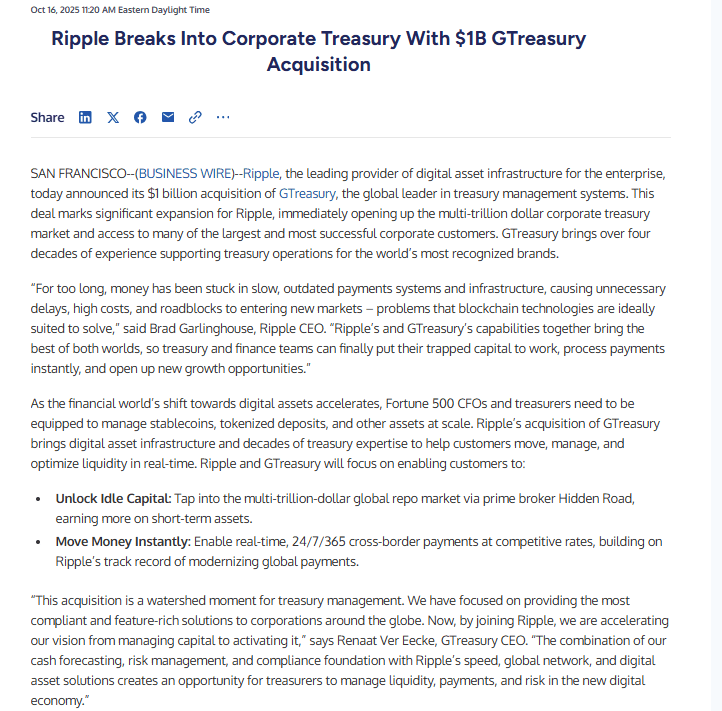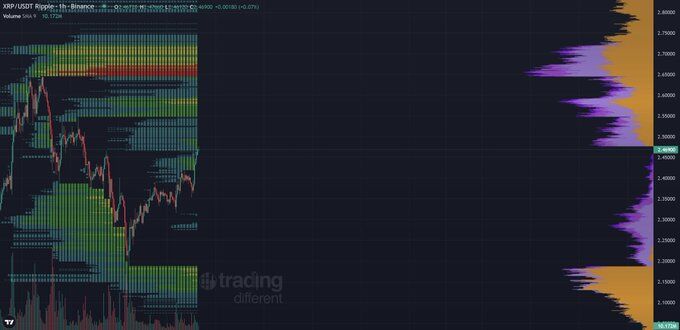Ripple advanced its enterprise stack and institutional coverage this week, while the XRPL Lending Protocol moved into a public security-testing phase. Developer channels also confirmed an October devnet reset tied to a pending amendment.
Corporate treasuries: Ripple moves to acquire GTreasury for $1B
Ripple announced an agreement to acquire GTreasury for $1 billion. The deal places Ripple’s infrastructure alongside a long-standing treasury management platform used by large enterprises. The parties dated the announcement to October 16.

The acquisition targets the corporate treasury market, where companies manage liquidity, risk, and compliance. By pairing payments and stablecoin infrastructure with treasury software, Ripple positions its stack inside existing finance workflows. The seller confirmed the transaction and noted closing remains subject to approvals.
Media desks repeated the headline numbers and timing. However, the core facts remain the same as the original release: $1 billion headline value, GTreasury as the target, and enterprise treasury as the addressable market.
Institutional custody: Absa collaboration brings Ripple tech to South Africa
Ripple said it is collaborating with Absa, one of South Africa’s largest banks, to provide institutional-grade digital asset custody. The announcement framed the service as secure and compliant for tokenized assets, including cryptocurrencies. Ripple’s social feed linked to the update on October 15.

Regional press described the bank’s plan to offer custody using Ripple’s technology. The move adds an African footprint for institutional safekeeping and aligns with growing demand for regulated infrastructure. Publication timestamps place the reports within the past few days.
Security program: XRPL Lending Protocol enters “Attackathon” window
Immunefi listed a $200,000 Attackathon for the XRPL Lending Protocol. The schedule opens with an education period from October 13 to October 27, followed by active testing from October 27 to late November. The program invites white-hat researchers to probe the protocol before launch.
Immunefi’s event page shows the attack window running October 27 through November 24 in one view, and through November 29 in the launch blog. Both sources confirm start on October 27 and the total reward pool. The entries also specify KYC, triage by Immunefi, and RLUSD as the rewards token.
Industry press summarized the same framework: a pre-launch bug hunt to harden an institutional lending design on the XRP Ledger. The report dates the disclosure to mid-October and points to the uncollateralized loan model as a core design element under review.
Developer note: XRPL devnet reset tied to PermissionDelegation
XRPL’s community blog recorded a devnet reset in October. Maintainers cited the PermissionDelegation amendment and the risk of validators becoming amendment-blocked in an upcoming rippled release as the reason. The post confirms that the reset completed and devnet returned to normal operation.
The advisory sits alongside a late-September vulnerability disclosure related to PermissionDelegation. That document lists affected versions and timing for the report, providing context for operators and developers tracking the amendment’s path.
The blog’s index keeps both notices in view for developers planning upgrades. Together, they outline the October maintenance actions and the current operational state.
XRP six-month chart points to continuation, trader maps $5 → $8–$13 → $27
A six-month XRP/USD chart shared by @ChartNerdTA frames the past seven years as two large symmetrical triangles ending in upside breaks. The analyst argues the latest structure remains intact “even with that nasty wick,” signaling no bearish trend flip and favoring continuation.

The chart sequence starts with a breakout impulse, then a tightening range, and now another expansion phase. On this view, XRP first targets about $5 in the next leg. After that, the roadmap shows a mid-cycle zone around $8–$13, where the market could consolidate before any final extension.
For cycle targets, the overlay uses Fibonacci extensions drawn on the multi-year structure. The levels highlighted are the 1.272 (~$8.60), 1.414 (~$13.94), and 1.618 (~$27.89), with the last marked as a potential blow-off top. The setup assumes the rising trendline on the six-month candles holds; a decisive close back inside the triangle or below the trendline would weaken this path. However, while momentum and structure point up in this model, liquidity conditions and news flow can still change the tape.
XRP liquidity map flags a fast lane to $2.55–$2.60, heavy supply near $2.70–$2.80
XRP trades into a low-volume pocket on the right-side volume profile, just above ~$2.40. When price enters these thin zones, it often moves quickly until it meets the next high-volume node. Here, that first magnet sits around ~$2.55–$2.60.

Above, the profile thickens again. Liquidity clusters and heatmap offers mark heavier resting supply around ~$2.70–$2.80. If buyers clear ~$2.60, the path likely slows into that band as limit sell orders absorb flow. Acceptance above ~$2.80 would require fresh demand and typically follows consolidation.
On the downside, supports stack at prior high-volume nodes near ~$2.28–$2.32 and deeper at ~$2.15–$2.20. Pullbacks into those zones often find bids if the trend stays intact. However, liquidity can shift; if top-of-book orders pull, momentum can fade quickly. Keep in mind this view reads order density, not conviction—spot flow and news can still redraw the map.
